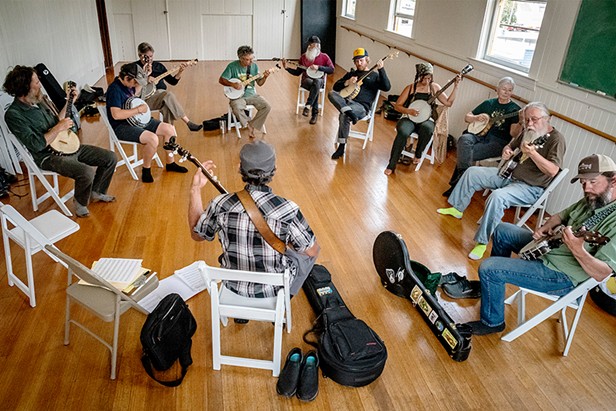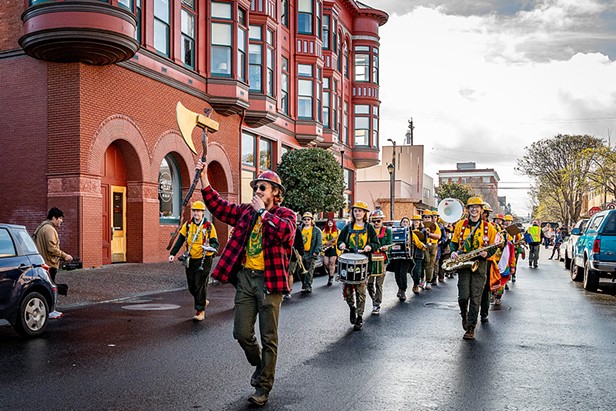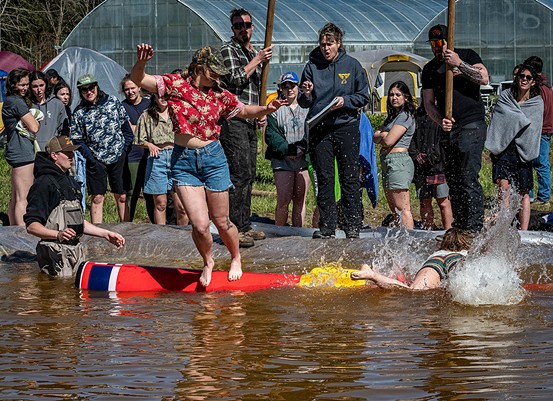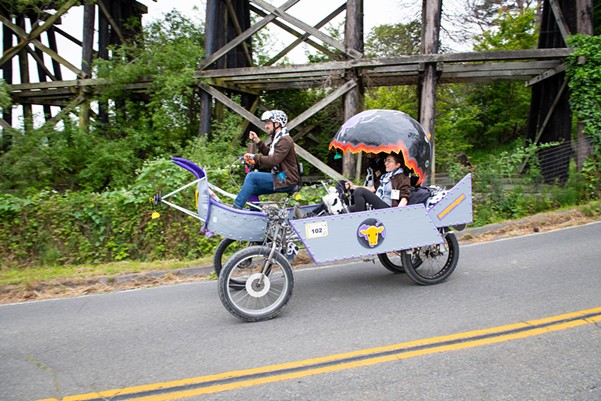Switch to the mobile version of this page.
- Username /
- Edit Settings /
- View Profile /
- Log Out
Browse This Week
- News
- Letters & Opinion
- The Week in Weed
- Seriously?
- NCJ Preview | Video
- E-Editions
- Pick Up a Print Edition
- NCJ Merch
- Giveaways + Events
- Memberships & Subscriptions
- Browse Archives
- Submit a Letter
- Submit News Tips
Browse Music
Browse Arts + Scene
- Screens
- Art Beat
- Art Walks
- Front Row
- Poetry
- Submit a Photo
- Submit an Event
- Submit or Edit a Location
- Browse Archives
Browse Eat + Drink
- On the Table
- What's Good
- Restaurants A-Z
- Bars + Night Clubs
- Breweries + Tap Rooms
- Wineries + Tasting Rooms
- Submit or Edit a Location
- Browse Archives
Browse Life + Outdoors
- Down and Dirty
- Field Notes
- Hum Bug
- Get Out
- Trophy Case
- Fishing the North Coast
- It's Personal
- North Coast Night Lights
- Humboldt Geographic
- Washed Up
- Crossword Puzzles
- Cartoons
- Wedding Guide
- Browse Archives
Browse NCJ Daily
Browse Classifieds
Browse Stories
Browse Food & Drink
Browse Perfect Trips
November 23, 2022 Slideshows » Life + Outdoors
2022 Mushroom Fair
By Mark Larson
Photo by Mark Larson
We frequently find one of our favorite colorful local mushrooms, Amanita muscaria, commonly known as the fly agaric or fly amanita, at Sue-meg State Park north of Trinidad, and sometimes all along nearby highway 101. According to sources, after emerging from the ground, the cap is covered with numerous small white to yellow pyramid-shaped warts. These are remnants of the universal veil, a membrane that encloses the entire mushroom when it is still very young.
Photo by Mark Larson
This table at the Humboldt Bay Mycological Society's Mushroom Fair held a collection of huge mushroom species, including Laetiporus sulphureus Chicken of the woods, a sulphur-yellow bracket fungus.
Photo by Mark Larson
Most of the volunteers at the Humboldt Bay Mycological Society's Mushroom Fair display tables kept Noah Siegel's popular book, Mushrooms of the Redwood Coast, in hand to help talk about the mushroom species in front of them.

Photo by Mark Larson
Andrew Wood Smyth, of McKinleyville, said, "This is my normal attire. Normal for mushroom fair attendees ...."
Photo by Mark Larson
Mushrooms costumes on the attendees and on the t-shirts for sale at the Humboldt Bay Mycological Society's Mushroom Fair .
Photo by Mark Larson
This attendee's t-shirt gave fair warning about likely a commonly shared trait among mushroom fans at the Humboldt Bay Mycological Society's Mushroom Fair.
Photo by Mark Larson
A lovely Amanita mushroom appeared in the crowd at the Humboldt Bay Mycological Society's Mushroom Fair. Amanita muscaria, commonly known as the Fly agaric or Fly amanita, this iconic large red mushroom, with its white spots, is one of the most recognizable fungi in popular culture. Illustrations of A. muscaria mushrooms fill many children's books, forming associations with magic, fairies, and the illusory world of the imagination. https://thethirdwave.co/psychedelics/amanita-muscaria. The name "Fly agaric" actually comes from a far more domestic purpose — as an insecticide that used the mushroom to kill the common house fly (Musca domestica). People would leave a piece of the mushroom's cap in a glass of water or milk, and the flies landing on the mushroom would be stunned, often drowning in the liquid. After emerging from the ground, the cap is covered with numerous small white to yellow pyramid-shaped warts. These are remnants of the universal veil, a membrane that encloses the entire mushroom when it is still very young.
Photo by Mark Larson
Mushroom prints on shirts and mushroom costumes were in the crowd of attendees at the Humboldt Bay Mycological Society's Mushroom Fair.
Photo by Mark Larson
Volunteer Dr. Bruce Kessler was back at his well-stocked "Toxic" mushroom table with his expertise on toxic mushrooms and likely medical outcomes if they're ingested at the Humboldt Bay Mycological Society's Mushroom Fair.
Photo by Mark Larson
A packed parking lot at the Arcata Community Center and a large crowd at every display table inside at the 44th annual Humboldt Bay Mycological Society's Mushroom Fair.
Photo by Mark Larson
Most of the volunteers at the display tables kept Noah Siegel's popular book, Mushrooms of the Redwood Coast, in hand to help talk about the mushroom species in front of them.
Photo by Mark Larson
Sydney Fisher Larson, of Arcata, worked her smartphone magic with a large display of oyster mushrooms, the common name for the species Pleurotus ostreatus, at Sue-meg State Park.
Photo by Mark Larson
We frequently find one of our favorite colorful local mushrooms, Amanita muscaria, commonly known as the fly agaric or fly amanita, at Sue-meg State Park north of Trinidad, and sometimes all along nearby highway 101. According to sources, after emerging from the ground, the cap is covered with numerous small white to yellow pyramid-shaped warts. These are remnants of the universal veil, a membrane that encloses the entire mushroom when it is still very young.
Photo by Mark Larson
Tiny mushrooms on a Douglas fir cone.Photo by Mark Larson
Photo by Mark Larson
We frequently find one of our favorite colorful local mushrooms, Amanita muscaria, commonly known as the fly agaric or fly amanita, at Sue-meg State Park north of Trinidad, and sometimes all along nearby highway 101. According to sources, after emerging from the ground, the cap is covered with numerous small white to yellow pyramid-shaped warts. These are remnants of the universal veil, a membrane that encloses the entire mushroom when it is still very young.
Photo by Mark Larson
We frequently find one of our favorite colorful local mushrooms, Amanita muscaria, commonly known as the fly agaric or fly amanita, at Sue-meg State Park north of Trinidad, and sometimes all along nearby highway 101. According to sources, after emerging from the ground, the cap is covered with numerous small white to yellow pyramid-shaped warts. These are remnants of the universal veil, a membrane that encloses the entire mushroom when it is still very young.
Photo by Mark Larson
We frequently find one of our favorite colorful local mushrooms, Amanita muscaria, commonly known as the fly agaric or fly amanita, at Sue-meg State Park north of Trinidad, and sometimes all along nearby highway 101. According to sources, after emerging from the ground, the cap is covered with numerous small white to yellow pyramid-shaped warts. These are remnants of the universal veil, a membrane that encloses the entire mushroom when it is still very young.
More slideshows
30 images
Mark Larson18 images
Mark Larson16 images
Mark Larson28 images
4/17
Photo by Mark Larson
Andrew Wood Smyth, of McKinleyville, said, "This is my normal attire. Normal for mushroom fair attendees ...."
Related Stories
Additional Slideshows
-
Life + Outdoors
Collegiate Logging Sports Competition / Forestry Clubs Conclave
By Mark Larson | March 18, 2024
-
Life + Outdoors
Perilous Plunge 2024
By Mark Larson | March 12, 2024
-
Life + Outdoors
Clam Beach Run 2024
By Mark Larson | February 6, 2024
-
Life + Outdoors
Humboldt Folklife Festival 2023
July 31, 2023
-
Life + Outdoors
Annie & Mary Day 2023
July 13, 2023
-
Arts + Scene, Life + Outdoors
Kinetic 2023 Day 3
By Jennifer Fumiko Cahill | May 30, 2023







































